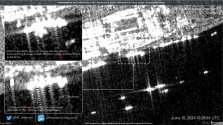My guess is a construction method or something for the foundations of that building, you can see the rolls in the June pictureWhat's up with the field which was gray-green in the first picture but is largely blue in the second picture?
You are using an out of date browser. It may not display this or other websites correctly.
You should upgrade or use an alternative browser.
You should upgrade or use an alternative browser.
09III/09IV (093/094) Nuclear Submarine Thread
- Thread starter SinoSoldier
- Start date
Possibly scattering by fine atmospheric dust. Just a dustier day maybe.What's up with the field which was gray-green in the first picture but is largely blue in the second picture?
In Fig. 12 you can see that the imaginary component of the refractive index (the part responsible for absorption) for an aerosol increases as wavelength decreases, indicating greater absorption of bluer light.
I dont think there was a accident at all, I thing they dredging for something there, working for more space. They move the pier <I guess is a floating pier> to avoid damaging it
View attachment 136585
They expanded the facilities with new buildings in less than a month
View attachment 136588
They were dredging the pier to be deep enough so an SSBN could actually sink there.
A submarine can have unbalanced forces on it if you purposely fill 1 side of the ballast tanks and not the other. But otherwise in an accidental sinking, the interior compartments are open. Water entering from the top can freely flow to its lowest energy configuration, which is all water at the bottom. If the hull was compromised, like in a regular sinking, and compartments were closed, yes sure it can list. But that is unlikely since hull compromise on a brand new sub is obvious.
There are also horizontal stabilizers in shallow water that can resist torque.
If you can see the shadow of the submarine hull, why wouldn't you be able to see the conning tower at the same depth?
You know this isn't without historical precedent either. In 1960s USS Guitarro sank at a river shipyard. Here's how it sank:
1. Straight down.
2. With the conning tower visible.
The sinking was fairly obvious.
That's the thing -- if there was a sinking, we don't know how the water entered into it. There is certainly no reason to think it had to have entered through the top of the submarine. What if it was a problem with the ballast tank on one side which caused ingress of water which caused it to tip over before letting in more water in an asymmetric way?
The quality of the imagery and the depth of the water makes it unclear if we would be able to see a submerged submarine on its side.
All of which isn't to say that I believe that there was a sinking. In fact, to repeat what I wrote before: the point I'm making is that technically speaking, the satellite picture we have can neither prove nor disprove anything and is basically useless.
If one wants to make an adamant argument against the idea of a submarine having sunk, your argument would be stronger if you did not use the satellite image as evidence, because one can easily turn the argument against you and say it could have sunk in a different manner where it wouldn't be visible to above the water anyhow.
I also use historical precedents of actual submarine sinkings at dock. Otherwise nobody can prove a negative.That's the thing -- if there was a sinking, we don't know how the water entered into it. There is certainly no reason to think it had to have entered through the top of the submarine. What if it was a problem with the ballast tank on one side which caused ingress of water which caused it to tip over before letting in more water in an asymmetric way?
The quality of the imagery and the depth of the water makes it unclear if we would be able to see a submerged submarine on its side.
All of which isn't to say that I believe that there was a sinking. In fact, to repeat what I wrote before: the point I'm making is that technically speaking, the satellite picture we have can neither prove nor disprove anything and is basically useless.
If one wants to make an adamant argument against the idea of a submarine having sunk, your argument would be stronger if you did not use the satellite image as evidence, because one can easily turn the argument against you and say it could have sunk in a different manner where it wouldn't be visible to above the water anyhow.
However I must point out that if they have to invent more and more contrived scenarios in the face of simple questions then it is a bad sign for their credibility when the alternative scenario - nothing sank - isn't changing.
It is like how it looked very bad for geocentric star systems when they had to add epicycles to compete with heliocentric ones.
Equation
Lieutenant General
It's probably using the blue tarp for the concrete foundation construction, common for metal fabrication warehouse type buildings.What's up with the field which was gray-green in the first picture but is largely blue in the second picture?
Covering the foundation after being poured helps to increase the heat therefore to cure the concrete faster.
I also use historical precedents of actual submarine sinkings at dock. Otherwise nobody can prove a negative.
However I must point out that if they have to invent more and more contrived scenarios in the face of simple questions then it is a bad sign for their credibility when the alternative scenario - nothing sank - isn't changing.
It is like how it looked very bad for geocentric star systems when they had to add epicycles to compete with heliocentric ones.
In theory of course, I agree with you.
The inability to prove a negative, is exactly why trying to make a watertight (no pun intended) argument is impossible and trying to push too hard in that direction is going to be futile.
It ends up in stalemate of "no one can definitively know what, if anything is there".
if it tipped over on the side, it would've caused damaged to the pier.That's the thing -- if there was a sinking, we don't know how the water entered into it. There is certainly no reason to think it had to have entered through the top of the submarine. What if it was a problem with the ballast tank on one side which caused ingress of water which caused it to tip over before letting in more water in an asymmetric way?
The quality of the imagery and the depth of the water makes it unclear if we would be able to see a submerged submarine on its side.
All of which isn't to say that I believe that there was a sinking. In fact, to repeat what I wrote before: the point I'm making is that technically speaking, the satellite picture we have can neither prove nor disprove anything and is basically useless.
If one wants to make an adamant argument against the idea of a submarine having sunk, your argument would be stronger if you did not use the satellite image as evidence, because one can easily turn the argument against you and say it could have sunk in a different manner where it wouldn't be visible to above the water anyhow.
That's my main issue with the claim of a major accident. How do you get to that point without causing more damage to nearby. And how do you move such a large piece in 1 day? Are cranes even what you would want to use in such a scenario?
if it tipped over on the side, it would've caused damaged to the pier.
That's my main issue with the claim of a major accident. How do you get to that point without causing more damage to nearby. And how do you move such a large piece in 1 day? Are cranes even what you would want to use in such a scenario?
Well if it tipped over where the sail faces the river rather than the pier, it wouldn't have necessarily caused significant damage.
We can see that in the picture with the various cranes gathered around the pier, the pier has also been repositioned so we cannot rule out if there may have been some form of damage that we cannot visualize.
It's also not like we have continuous day to day good quality imagery of the events there anyway (if there was such imagery then none of this would be a problem because we'd all know what had happened).
IMO, the people who are using the satellite images we have at hand, to declare that there was a major accident or sinking are being silly. However I think people cannot use the satellite images to argue the other point definitively either -- the images cannot prove that there was no accident or sinking.
The pictures are entirely indecisive.


